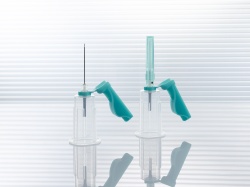manufacturer
Cutting the risks of injury and contamination
Austrian firm Greiner Bio-One is presenting products for the pre-analysis and diagnostics industry at this year’s Medica. Vacuette safety products have been developed to minimise this risk of injuries from contaminated puncture devices – a significant safety hazard to healthcare workers, the firm underlines.

‘Special product solutions, such as the Vacuette Quickshield Safety Tube Holder with 360° rotatable safety shield, or the Vacuette Premium Blood Collection Tubes with safety screw cap, reduce the risk of injury or contamination to an absolute minimum.’ For rapid identification of nosocomial infections, Greiner Bio-One developed Genspeed, a molecular diagnostics system that combines crude lysis of bacteria with multiplex PCR followed by automated analysis of PCR products in the new Genspeed R2 analyser.
‘The Genspeed Test System stands out in terms of speed and high sensitivity,’ the manufacturer points out. ‘Analyses of individual samples can be made at any time. The three controls (for DNA amplification, hybridisation, as well as a negative control) on the Test Chip guarantee maximum reliability.’ The system is also reported to be compact and maintenance-free and easy to use. ‘Pre-filled reagents and the automated Genspeed R2 analyser reduce the number of process steps to a minimum,’ Grenier Bio-One adds about this newly available in Europe product. ‘One example is the Genspeed MRSA Test, a DNA-based, in-vitro, diagnostic tool for the qualitative detection of MRSA within 75 minutes from human nasal and pharyngeal smears. It features the detection of the two relevant resistance genes, mecA and mecC.’
Greiner Bio-One is at Medica
Hall 03 / Stand G60
10.11.2014





